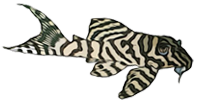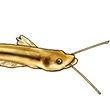Hiya,
lastly I start doing bigger waterchanges (around 30% weekly since fish get bigger). Tank is 200l with 5x p. typus, 6x lophiobagrus brevispinis and 5x s. petricola "burundi" + 3xN.Leleupi (to see if fish are ok).
I do 15% waterchange twice a week (earlier I do 20% waterchange once a week).
What changed? Petricolas start to swim actively during a daytime. It's good but they swim only behind the internal filter next to the glass (I will post photos in 7 hours for better explanations).
They are around 3cm now. When I get them (3 months ago) they were around 1-1.5cm so they grow nicely :). But there is another thing that have changed. They become slender. When they were smaller they always got nice, rounded belly - is it normal for them to get slender with age? On all photos I found here on the forum and on cat-elog petricolas are always slender but photos show mature fish. Firstly I thought it's because phyllonemus eat everything before petricolas get to the food but I tried direct feeding synos and they are not interested in food (I also feed in 3 different places) :/ - they just keep swimming - strange for synodontis. However I try direct feeding during a daytime so maybe thats why they do not eat since I always feed them during a night till now.
Other thing which bother me. Sometimes I can see petricolas scratching their head - not very often but one speciment stop swimming with group, go to the ground scratch his head few times and come back swimming in circles. I didn't notice scratching in other fish.
Tank size is: 100x45x50 (lxwxh), lots of sandrocks and hydrilla verticillata.
Feeding after turning off the lights:
Welsi-gran (granules made for catfishes by Tropical - polish firm).
Crushed TetraMin flakes
Tetra WaferMix
Frozen white worms and daphnia.
Sometimes crushed spirulina flakes (40% of spirulina).
Once a week I feed live whiteworms (phyllonemus go crazy for them) and sometimes live artemia.
I know Sidguppy you don't consider granules as a good food but phyllonemus and lophios just love it and I think they do not like TetraMin very much.
Here goes another question: what exactly flake food you (who keep phyllonemus typus) feed your fish. I please for full name and firm since I was unable to find flakes which my catfish would love more than granules.
Ph is around 8 (7.8-8.2 - not sure because of tests quality).
No3 - was always below 20mg/l but I've just noticed my test is after time limt ;] for abour a month.
No2 - 0mg/l.
I have no other tests.
Tank is running for 3 months (2 months with fish in it).
Friend of mine who keeps WC tropheus for a long time and also WC s. dhonti ("dwarf" probably) for a some time - he's for sure experienced - told me that swimming next to the glass can be signs of stress (in tropheus case) and scratching could be caused by something in water (since winter just started here and something can be add to tapwater).
He suggest adding salt (3 spoons for 100l) and start carbon filtration. I will probably do that because he is only one person in my freaking country who also keep tanganyikan catfishes (not exactly only one - we got around 5 ppl with tang. synos now but they are not very experienced with tang. fishes).
He said salt won't cause any problems and it will help get rid of few possible parasites (scratching) and also do fine with osmosis - I don't know words to explain exactly what he wrote me about osmosis - sorry.
I know it's lot of questions and prolly not correctly written and you are tired now but please help me :).
I ask for your opinion since keeping fish no one else have in your country could be cool as long as everything is fine - when something happen you gain experience but also during gaining process you can lost fish which I don't want to happen. So please share yours experience :) with crawling person :).
Regards and thanks.
s. petri - behaviour changed - good or bad?
- worton[pl]
- Posts: 621
- Joined: 08 Jul 2004, 19:13
- My images: 2
- My cats species list: 11 (i:0, k:0)
- My aquaria list: 3 (i:2)
- Spotted: 1
- Location 1: Lublin, Poland
- Location 2: Warsaw, Poland
- Interests: catfishes, motorcycles
- Contact:
s. petri - behaviour changed - good or bad?
Like a true nature's child
We were born, born to be wild
We can climb so high
I never wanna die
Born to be wild
Born to be wild
Steppenwolf, Born to Be Wild
We were born, born to be wild
We can climb so high
I never wanna die
Born to be wild
Born to be wild
Steppenwolf, Born to Be Wild
- worton[pl]
- Posts: 621
- Joined: 08 Jul 2004, 19:13
- My images: 2
- My cats species list: 11 (i:0, k:0)
- My aquaria list: 3 (i:2)
- Spotted: 1
- Location 1: Lublin, Poland
- Location 2: Warsaw, Poland
- Interests: catfishes, motorcycles
- Contact:
Well I did a 40l waterchange with add 2 teaspoons of salt - they are eating today ;). I also forgot to write that I got shrimp only tank running on my tap water so if in water appear some chemical compounds shrimps should die as first so I didn't start carbon filtration.
I just wonder why petricolas scratch and why they swim only in one place - maybe they feel safer there?
Anyway questions about feeding phyllonemus are still current ;).
Thanks!
I just wonder why petricolas scratch and why they swim only in one place - maybe they feel safer there?
Anyway questions about feeding phyllonemus are still current ;).
Thanks!
Like a true nature's child
We were born, born to be wild
We can climb so high
I never wanna die
Born to be wild
Born to be wild
Steppenwolf, Born to Be Wild
We were born, born to be wild
We can climb so high
I never wanna die
Born to be wild
Born to be wild
Steppenwolf, Born to Be Wild




